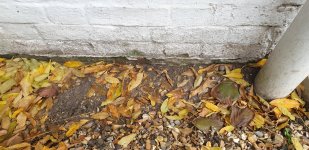I notice there is some green where the cold dives in to the wall. Tends to suggest to me that the wall is damp. Cold pipes will go green in a damp wall because moisture in the wall condenses out on the pipes. Whether the damp is coming from the ground, outside or a leaky stopcock I can't say. I would clean it all off and continue to look for leaks. Certainly a small leak can affect an area that big. Normally I would just replace anything that looks dodgy but that stopcock is a world of pain so better to be sure it is leaking before you replace it. I normally make sure there is plenty of room hacked out around the stopcock, clean with a little wire wool, dry everything off, and look for leaks with a little toilet tissue.
Sections off that wall are indeed damp.. flaking paint etc. I'm just note sure if the damp is due to the wall being old (1850s) and poorly DPC'd or it is due to the moisture from the pipe. When I removed the plaster from around the pipe is was very soft..
But I suspect the wall itself is the issue as similarly aged walls else where in the property have been painted white by the previous owned and are now turning yellow and flaking.




